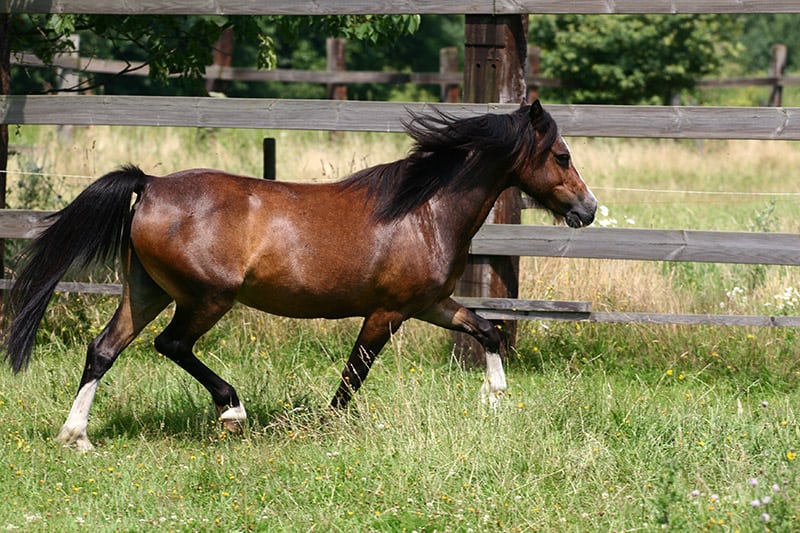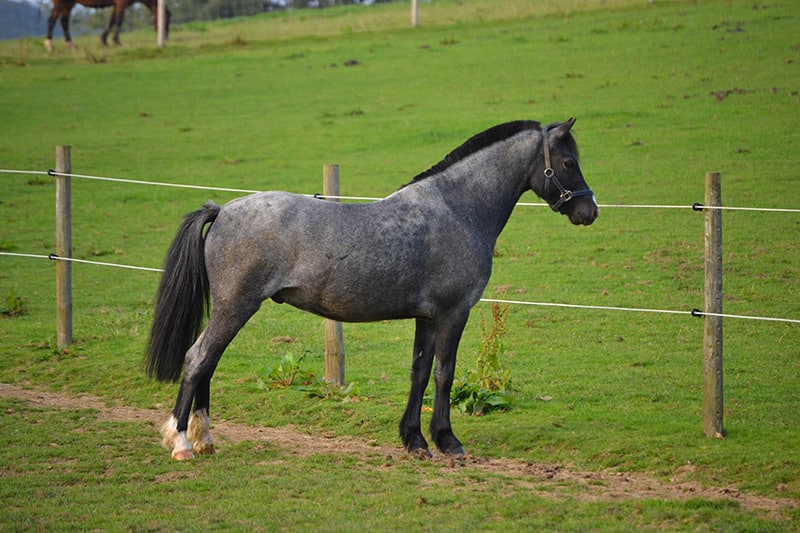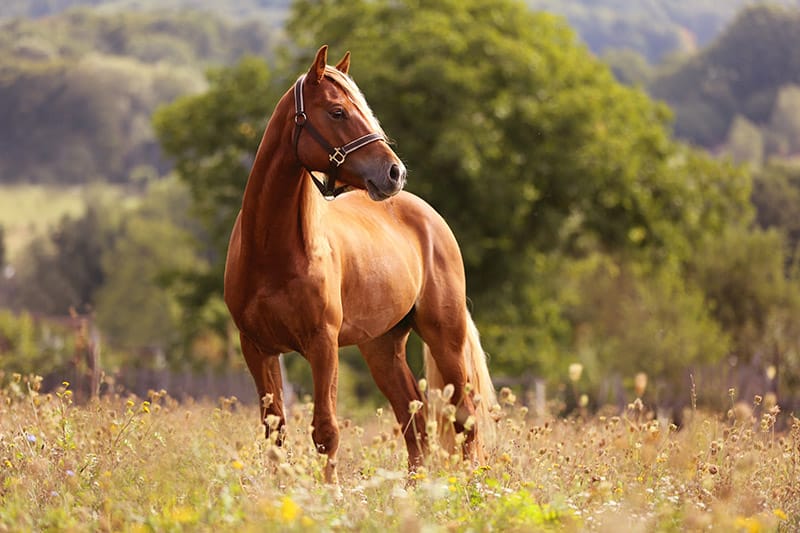There are several types of Welsh Ponies, and all are descended from the Welsh Mountain Pony!
The Welsh Pony is a breed which can trace its roots back before the time of Julius Caesar. They are an old breed which has evolved through necessity to become vigorous and resilient. Their heritage began with the rugged Welsh Mountain Pony which, with the arrival of the Romans, was infused with the blood of desert bred horses. They were nearly destroyed when King Henry III arrived on the scene. He wanted large strong horses to carry his armored knights so decreed all small horses under 15 hands high be destroyed. Only those released back into the hills by local Welshmen survived. They were later recaptured, and some were then bred with large Draft Horses, creating the Welsh Cob.
Today there are four types of Welsh Pony, varying by size. There is the Welsh Mountain Pony which is under 12 hands high, the Welsh Pony and the Cob Type Welsh Pony which are both under 13.2 hands high, and the Welsh Cob which is 13 hands high or taller.
The Welsh Pony is blessed with grace and natural jumping ability. these good natured ponies have long been an excellent choice both for riding or driving in competition as well as for pleasure. They are easy going and friendly, and make excellent companions for children and adults alike. Professionally trained ponies are recommended for children and beginners.
The Welsh Ponies arrived in the U.S. in 1880 when George Brown of Aurora, Illinois imported many of them. He spearheaded the formation of the Welsh Pony and Cob Society of America in 1906. Today, there are over 45,000 welsh ponies registered in the United States. They are divided into four sections by size and type.
Scientific Classification
| Kingdom: | Animalia |
| Phylum: | Chordata |
| Class: | Mammalia |
| Order: | Perissodactyla |
| Family: | Equidae |
| Genus: | Equus |
| Species: | caballus |
Horse Breeds
The Welsh Pony is one of the pony breeds. Ponies are generally considered to be 14.2 hands or smaller at maturity, however this is a general rule with many exceptions. Pony breeds have a slightly different appearance than the light horse breeds. They usually have thicker manes, tails and coats. They are proportionately shorter legged and rounder through the barrel. They have somewhat shorter and thicker necks and wider, stronger bones.
Ponies are well known for their superior intelligence and with good horse training, more tractable temperaments. Many of the pony breeds evolved where there was inferior nutrition and which resulted in a smaller breed. Ponies generally require less diligence in their care and often tend to be more independent than the other types of horses.
Well trained ponies can make wonderful mounts for children. Their small sizes make them less intimidating and are more closely matched to a child’s size and strength. They do well in many disciplines including driving, hunters on the flat and over fences, western driving classes, and pleasure riding. The can also show in dressage, equitation, show jumping, and other events; with top ponies even being competitive against full sized horses.

Horse Backgrounds
There are several types of Welsh Ponies today. All of them are descended from the Welsh Mountain Pony who lived in Wales prior to the Roman invasion. The rugged and isolated environment kept the ponies small, hardy, and sure footed.
With the arrival of the Romans, desert bred horses were introduced and interbred with the local ponies. What emerged displayed the hardiness and jumping ability of the original ponies. This was also coupled with the intelligence and refinement of the Arab breeds.
King Henry VIII brought about their near demise when he decreed all horses under 15 hands be destroyed in at attempt to force breeders to produce larger horses able to carry his armored knights. The Welshmen returned the ponies back to the hills, and they thrived, becoming self reliant and athletic. With the passing of Henry VIII the farmers recaptured the ponies and bred the larger ones with draft breeds, giving rise to the Welsh Cob.
Description
There are four types of Welsh Ponies. They are divided into four sections by size and type, and include:
- Section A – Welsh Mountain Pony: The Welsh Mountain Pony is under 12hh (hands high).
- Section B – Welsh Pony: The Welsh Pony is under 13.2hh.
- Section C – Cob Type Welsh Pony: The Cob Type Welsh Pony is also under 13.2hh.
- Section D – Welsh Cob: The Welsh Cob is 13.hh and taller. It is heavier than the other types and retains the feathering on the fetlocks and lofty knee action of their draft ancestors. It is not uncommon for the Welsh Cob to reach up to 16hh.
All solid colors are allowed except piebald and skewbald, and white markings are permitted on the legs and face. Their smallish head retains some of the look of the Arab, being slightly concave or straight, but never convex. They should have an arched neck attached to a well proportioned body and a high set on tail.
Horse Care and Feeding
Welsh ponies are generally hardy and do extremely well in a pasture situation. If kept indoors in a box stall or barn, daily turnout is very important. Grass hay or alfalfa is sufficient, with additional vitamin and mineral supplements added if the horse is in regular work or training.The Cob types require regular grooming to prevent scratches from developing on their fetlocks.
These ponies were bred to be outdoors and social, so they are best kept in the company of other horses.

Horse Training and Activities
Due to their good nature, Welsh Ponies make a great choice for riding and driving pleasure. Characteristic of a sports pony, the Welsh Pony excels both in the dressage arena and the jumping field. They make excellent choices for juniors and small adults as eventers, show jumpers and dressage horses. They also make a fine and powerful harness horses.
Common Health Problems
The Welsh Pony is hardy and disease resistant by nature. Owners must be careful not to “kill them with kindness”. Welsh ponies may be prone to laminitis, so sugar and carbohydrate consumption should be monitored. Care should be taken when allowed to graze on rich grass or hay. The Cob varieties may also develop scratches beneath their feathered fetlocks, so good grooming is essential.
Availability
Unbroken Welsh Ponies can be found for less than $5,000. However, professionally trained ponies are recommended for children and beginners. These range in price from $5,000 to $50,000 and up, depending on their training and show experience. The Welsh Pony website www.welshpony.org, maintains a list of breeders and sellers.
Featured Image Credit: Helga Madajova, Shutterstock
